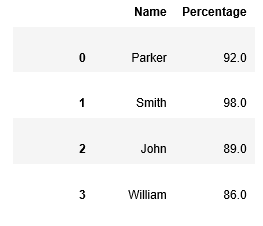Pandas DataFrame.groupby()
In Pandas, groupby() function allows us to rearrange the data by utilizing them on real-world data sets. Its primary task is to split the data into various groups. These groups are categorized based on some criteria. The objects can be divided from any of their axes.
Syntax:
This operation consists of the following steps for aggregating/grouping the data:
- Splitting datasets
- Analyzing data
- Aggregating or combining data
Note: The result of Groupby operation is not a DataFrame, but dict of DataFrame objects.
Split data into groups
There are multiple ways to split any object into the group which are as follows:
- obj.groupby(‘key’)
- obj.groupby([‘key1′,’key2’])
- obj.groupby(key,axis=1)
We can also add some functionality to each subset. The following operations can be performed on the applied functionality:
- Aggregation: Computes summary statistic.
- Transformation: It performs some group-specific operation.
- Filtration: It filters the data by discarding it with some condition.
Aggregations
It is defined as a function that returns a single aggregated value for each of the groups. We can perform several aggregation operations on the grouped data when the groupby object is created.
Example
Output
Course B.Ed 98 B.Sc 82 BA 87 M.Phill 91 Name: Percentage, dtype: int64
Transformations
It is an operation on a group or column that performs some group-specific computation and returns an object that is indexed with the same size as of the group size.
Example
Output
Percentage 0 NaN 1 NaN 2 NaN 3 NaN
Filtration
The filter() function filters the data by defining some criteria and returns the subset of data.
Example
Output
Name Percentage Course 0 Parker 82 B.Sc 1 Smith 98 B.Ed 2 John 91 M.Phill 3 William 87 BA
Parameters of Groupby:
- by: mapping, function, str, or iterable
Its main task is to determine the groups in the groupby. If we use by as a function, it is called on each value of the object’s index. If in case a dict or Series is passed, then the Series or dict VALUES will be used to determine the groups.
If a ndarray is passed, then the values are used as-is determine the groups.
We can also pass the label or list of labels to group by the columns in the self.
- axis: {0 or ‘index’, 1 or ‘columns’}, default value 0
- level: int, level name, or sequence of such, default value None.
It is used when the axis is a MultiIndex (hierarchical), so, it will group by a particular level or levels.
- as_index: bool, default True It returns the object with group labels as the index for the aggregated output.
- sort: bool, default True It is used to sort the group keys. Get better performance by turning this off.
Note: It does not influence the order of observations within each group. The Groupby preserves the order of rows within each group.
- group_keys: bool, default value True
When we call it, it adds the group keys to the index for identifying the pieces.
- observed: bool, default value False It will be used only if any of the groupers are the Categoricals. If the value is True, then it will show only the observed values for categorical groupers. Otherwise, it will show all of its values.
- **kwargs
It is an optional parameter that only accepts the keyword argument ‘mutated’ that is passed to groupby.
Returns
It returns the DataFrameGroupBy or SeriesGroupBy. The return value depends on the calling object that consists of information about the groups.
Example
Output

Example
Output
Name Percentage 0 Parker 82 1 Smith 98 2 John 91 3 William 87
